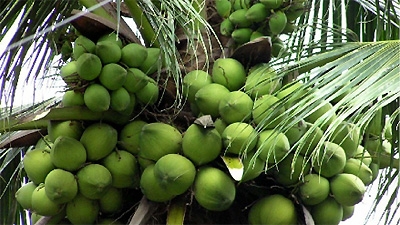Coconut palms - symbol of Ben Tre
 They can travel in a small along the rivers or canals in the shade of coconut trees and stop on the way to relax in fruit orchards and coconut gardens.
They can travel in a small along the rivers or canals in the shade of coconut trees and stop on the way to relax in fruit orchards and coconut gardens.
Ben Tre is located in the lowest part of the Mekong River basin, some 85km south of Ho Chi Minh City. It has three main islands wedged between the Tien Giang River to the north and the Co Chien River to the south, with the Ham Luong River running straight down the middle. All of these rivers are offshoots of the Mekong as it splits out into many fingers before flowing into the South Asian Sea.
The province is famous for its rice and fruit cultivation, but its traditional life has changed little over time, with tourists wandering through the markets, sipping coffee, taking boat trips and visiting local museums.
Coconut palms have become the symbol of Ben Tre since land was first reclaimed in the southern part of the country. During the war, coconuts were used to make coconut oil, which served as a viable substitute for kerosene. The province now has nearly 36,000 hectares of coconut plantations that have survived through protracted wars and remain dear to the hearts of local people.
There was a time when many people in Ben Tre felled coconut trees for some economic reasons, but now they have replanted them, producing around 242 million coconuts each year.
Many handicrafts are made from coconut materials including sandals, dolls, small baskets, bed lamps and vases. Tourists can visit local coconut candy factories to watch the candy being made and also buy some to take home as special gifts for their family and friends.
In addition to coconuts, Ben Tre is also known as the "king" of specialty fruit, with 41,000 hectares of orchards yielding 375,000 tonnes of fruit a year. Some of the province's unique specialties include milky yellow-fleshed and stoneless durians, green-skinned pomelos, Cai Mon mangosteens, high-yield "Four Season" mangos, and special Mo Cay oranges.
What the stars mean:
★ Poor ★ ★ Promising ★★★ Good ★★★★ Very good ★★★★★ Exceptional
 Tag:
Tag:
Related Contents
Latest News
More News
- Vietjet launches daily Manila flights to celebrate year-end festive peak season (December 05, 2025 | 13:47)
- The destinations powering Vietnam’s festive season travel demand (December 04, 2025 | 18:33)
- Vietnam named among the world’s most exciting winter destinations (December 04, 2025 | 15:10)
- Phu Tho emerges as northern Vietnam’s new tourism hub (December 01, 2025 | 17:00)
- Vietjet completes Airbus A320/A321 updates ahead of deadline (December 01, 2025 | 09:49)
- Vietjet resumes Con Dao flights from early December (November 28, 2025 | 15:24)
- Free tickets, Lunar New Year promotions on offer at Vietjet Mega Livestream (November 26, 2025 | 15:32)
- Scandinavian Airlines and Vietnam Airlines broaden agreement with new routes (November 25, 2025 | 17:04)
- Halong Cruise Port welcomes over 3,100 international visitors (November 12, 2025 | 18:06)
- Vietnam.travel climbs to second place in Southeast Asia website rankings (November 12, 2025 | 18:01)























 Mobile Version
Mobile Version